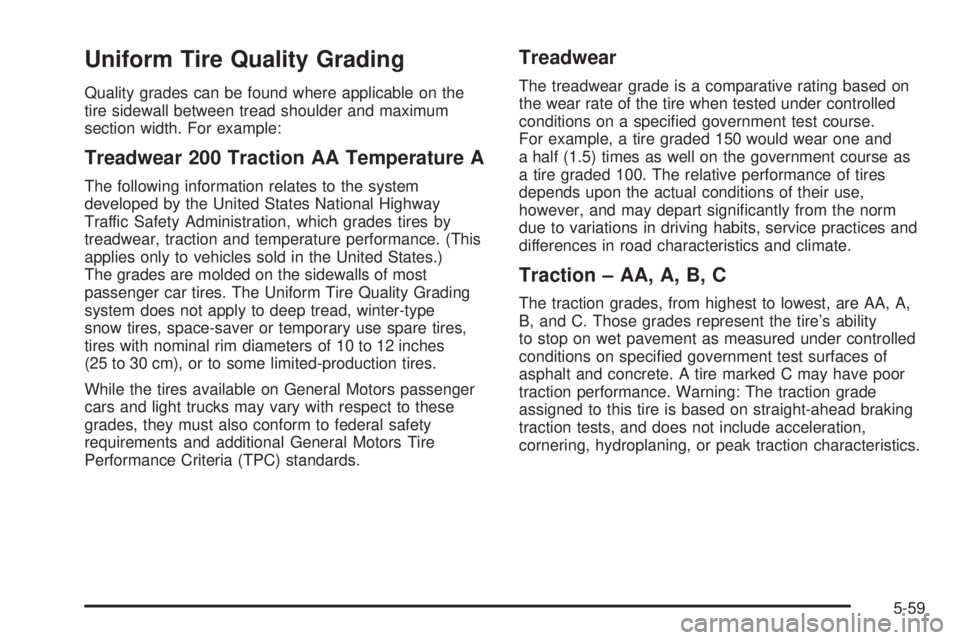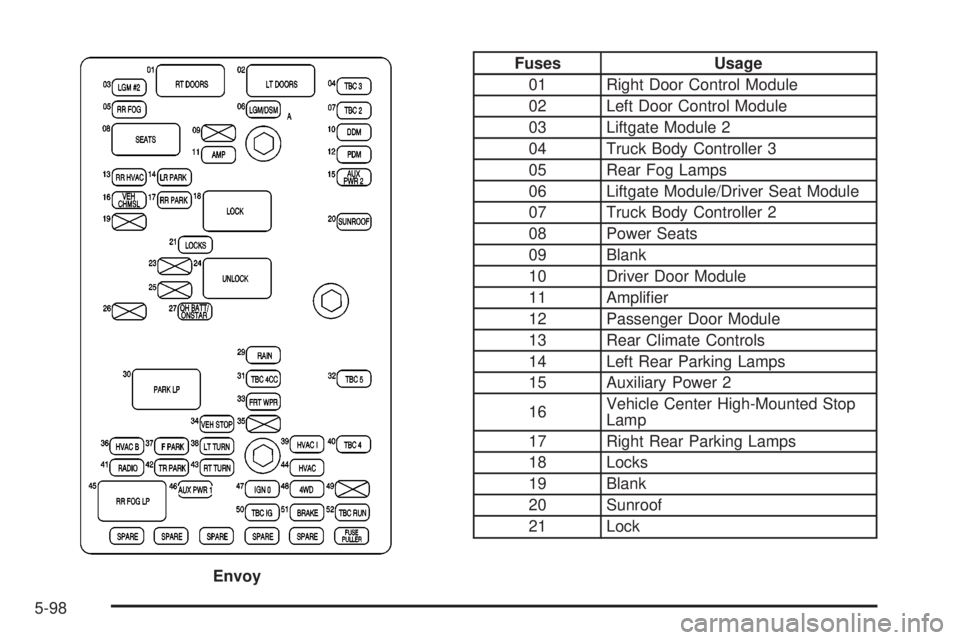climate control GMC ENVOY 2003 User Guide
[x] Cancel search | Manufacturer: GMC, Model Year: 2003, Model line: ENVOY, Model: GMC ENVOY 2003Pages: 442, PDF Size: 3.1 MB
Page 147 of 442

You may notice a slight change in engine performance
when the air-conditioning compressor shuts off and
turns on again. This is normal.
^(Air Conditioning Off):When you turn the air
conditioning off, the words A/C OFF will appear on the
display. When the air conditioning is selected or in
AUTO mode, the system will run the air conditioning
automatically.
Defogging and Defrosting
Fog on the inside of windows is a result of high humidity
(moisture) condensing on the cool window glass. This
can be minimized if the climate control system is
used properly. You can use either defog or front defrost
to clear fog or frost from your windshield.
-(Defog):Use this setting to clear the windows of fog
or moisture. This setting will deliver air to the ¯oor
and windshield outlets.
0(Front Defrost):Press the front defrost button to
clear the windshield and side windows of frost or
fog quickly. The system will automatically control the fan
speed if you select defrost from AUTO mode. If the
outside temperature is 40ÉF (4ÉC) or warmer, your air
conditioning compressor will automatically run to
help dehumidify the air and dry the windshield. Do not
drive the vehicle until all the windows are clear.
Rear Window Defogger
The rear window defogger uses a warming grid to
remove fog from the rear window.
<(Rear):Press this button to turn the rear window
defogger on or off.
An indicator light in the button will come on to let you
know that the rear window defogger is activated.
The rear window defogger will turn off approximately 10
minutes after the button is pressed. If you need
additional warming time, press the button again.
Notice:Don't use a razor blade or something else
sharp on the inside of the rear window. If you
do, you could cut or damage the defogger and the
repairs would not be covered by your warranty.
Do not attach a temporary vehicle license, tape, a
decal or anything similar to the defogger grid.
3-27
Page 149 of 442

Rear Climate Control System
Your Envoy has one of the following rear climate control
systems. With any of these systems, the rear climate
controls will be disabled when the front climate control
system is in defrost. This occurs to provide maximum
air¯ow to clear the windshield.
The temperature of the air coming through the rear
outlets is determined by the front passenger's
temperature setting. Press the PWR button to turn the
rear climate controls on and off. Use the mode knob
to change the direction of air¯ow (upper, bi-level or ¯oor)
to the rear seat area.If your vehicle has the rear seat audio system, the lower
buttons are used to adjust the rear seat climate
controls. The temperature of the air coming through the
rear outlets is determined by the front passenger's
temperature setting.
The middle button with the up and down arrows on it
regulates the fan speed. The right button is used
to change the direction of air¯ow (upper, bi-level or
¯oor) to the rear seat area. To turn the rear climate
controls off, press the left button.
3-29
Page 150 of 442

The left button with the up and down arrows on it
regulates the fan speed. The right button can be used
to change the direction of air¯ow (upper, bi-level or ¯oor)
to the rear seat area. To turn the rear climate controls
off, press the middle button.
Outlet Adjustment
Your vehicle may have rear seat outlets that can be
used to adjust the air¯ow toward either seating area, the
¯oor or upward. Move the control in the center of
each outlet in any direction to direct air¯ow.
3-30
Page 152 of 442

Turn the knobs on the control panel to choose a fan
speed, temperature and direction of air¯ow.
Selecting panel mode will deliver air to the four headliner
outlets. Selecting bi-level mode will deliver warmer air
to the third seat ¯oor outlet and cooler air to the
headliner outlets. Selecting ¯oor mode will deliver air to
the ¯oor outlet located in the third seat area.Press the buttons at the bottom of the audio control
panel to adjust the fan speed, mode and temperature for
the rear passengers. The selections will be shown on
the display.
Press the rear fan control button with the arrow pointing
right to turn the rear climate control on. Toggle this
button to adjust the air ¯ow speed. To turn the
rear system off, toggle the left arrow until the display
turns off. Envoy XL
Envoy XL
3-32
Page 153 of 442

Steering Wheel Climate Controls
You can adjust the fan
speed and temperature of
the front climate control
system by using the
buttons located on your
steering wheel.
9(Fan):Press the up or down arrow on this switch to
increase or decrease the fan speed.
B(Temperature):Press the up or down arrow on this
switch to increase or decrease the temperature of
the air ¯owing through the system.
Climate Controls Personalization
If your vehicle is equipped with the Driver Information
Center (DIC), you can store and recall the climate
control settings for temperature, air delivery mode and
fan speed for two different drivers. The personal
choice settings recalled are determined by the
transmitter used to enter the vehicle. After the button
with the unlock symbol on a remote keyless entry
transmitter is pressed, the climate control will adjust to
the last settings of the identi®ed driver. The settings
can also be changed by pressing one of the memory
buttons (1 or 2) located on the driver's door. When
adjustments are made, the new settings are
automatically saved for the driver.
3-33
Page 284 of 442

Driving with a Trailer
{CAUTION:
If you have a rear-most window open and you
pull a trailer with your vehicle, carbon
monoxide (CO) could come into your vehicle.
You can't see or smell CO. It can cause
unconsciousness or death. See ªEngine
Exhaustº in the Index. To maximize your safety
when towing a trailer:
·Have your exhaust system inspected for
leaks, and make necessary repairs before
starting on your trip.
·Keep the rear-most windows closed.
·If exhaust does come into your vehicle
through a window in the rear or another
opening, drive with your front, main heating
or cooling system on and with the fan on
any speed. This will bring fresh, outside air
into your vehicle. Do not use the climate
control setting for maximum air because it
only recirculates the air inside your vehicle.
See ªClimate Controlsº in the Index.Towing a trailer requires a certain amount of experience.
Before setting out for the open road, you'll want to get
to know your rig. Acquaint yourself with the feel of
handling and braking with the added weight of the trailer.
And always keep in mind that the vehicle you are
driving is now a good deal longer and not nearly as
responsive as your vehicle is by itself.
Before you start, check the trailer hitch and platform
(and attachments), safety chains, electrical connector,
lamps, tires and mirror adjustment. If the trailer has
electric brakes, start your vehicle and trailer moving and
then apply the trailer brake controller by hand to be
sure the brakes are working. This lets you check your
electrical connection at the same time.
During your trip, check occasionally to be sure that the
load is secure, and that the lamps and any trailer
brakes are still working.
4-56
Page 347 of 442

Uniform Tire Quality Grading
Quality grades can be found where applicable on the
tire sidewall between tread shoulder and maximum
section width. For example:
Treadwear 200 Traction AA Temperature A
The following information relates to the system
developed by the United States National Highway
Traffic Safety Administration, which grades tires by
treadwear, traction and temperature performance. (This
applies only to vehicles sold in the United States.)
The grades are molded on the sidewalls of most
passenger car tires. The Uniform Tire Quality Grading
system does not apply to deep tread, winter-type
snow tires, space-saver or temporary use spare tires,
tires with nominal rim diameters of 10 to 12 inches
(25 to 30 cm), or to some limited-production tires.
While the tires available on General Motors passenger
cars and light trucks may vary with respect to these
grades, they must also conform to federal safety
requirements and additional General Motors Tire
Performance Criteria (TPC) standards.
Treadwear
The treadwear grade is a comparative rating based on
the wear rate of the tire when tested under controlled
conditions on a speci®ed government test course.
For example, a tire graded 150 would wear one and
a half (1.5) times as well on the government course as
a tire graded 100. The relative performance of tires
depends upon the actual conditions of their use,
however, and may depart signi®cantly from the norm
due to variations in driving habits, service practices and
differences in road characteristics and climate.
Traction ± AA, A, B, C
The traction grades, from highest to lowest, are AA, A,
B, and C. Those grades represent the tire's ability
to stop on wet pavement as measured under controlled
conditions on speci®ed government test surfaces of
asphalt and concrete. A tire marked C may have poor
traction performance. Warning: The traction grade
assigned to this tire is based on straight-ahead braking
traction tests, and does not include acceleration,
cornering, hydroplaning, or peak traction characteristics.
5-59
Page 386 of 442

Fuses Usage
01 Right Door Control Module
02 Left Door Control Module
03 Liftgate Module 2
04 Truck Body Controller 3
05 Rear Fog Lamps
06 Liftgate Module/Driver Seat Module
07 Truck Body Controller 2
08 Power Seats
09 Blank
10 Driver Door Module
11 Ampli®er
12 Passenger Door Module
13 Rear Climate Controls
14 Left Rear Parking Lamps
15 Auxiliary Power 2
16Vehicle Center High-Mounted Stop
Lamp
17 Right Rear Parking Lamps
18 Locks
19 Blank
20 Sunroof
21 Lock
Envoy
5-98
Page 388 of 442

Fuses Usage
01 Right Door Control Module
02 Left Door Control Module
03 Liftgate Module 2
04 Truck Body Controller 3
05 Rear Fog Lamps
06 Liftgate Module/Driver Seat Module
07 Truck Body Controller 2
08 Power Seats
09 Rear Wiper
10 Driver Door Module
11 Ampli®er
12 Passenger Door Module
13 Rear Climate Controls
14 Left Rear Parking Lamps
15 Auxiliary Power 2
16Vehicle Center High-Mounted Stop
Lamp
17 Right Rear Parking Lamps
18 Locks
19 Blank
20 Vent Window
21 Lock
Envoy XL
5-100
Page 429 of 442

Charging System Light....................................3-38
CHECK WASHER FLUID.................................3-61
Checking Brake Fluid......................................5-39
Checking Coolant............................................5-25
Checking Engine Oil........................................5-15
Checking Things Under the Hood......................5-10
Checking Your Restraint Systems......................1-60
Check...........................................................3-42
Engine Light...............................................3-42
Gages Warning Light...................................3-48
Chemical Paint Spotting...................................5-86
Child Restraints..............................................1-36
Child Restraint Systems...............................1-36
Infants and Young Children...........................1-32
Lower Anchorages and Top Tethers for
Children (LATCH System)..........................1-42
Older Children.............................................1-30
Securing a Child Restraint Designed for
the LATCH System...................................1-44
Securing a Child Restraint in a Rear
Outside Seat Position...............................1-45
Securing a Child Restraint in the Center
Seat Position...........................................1-48
Securing a Child Restraint in the Right
Front Seat Position...................................1-48
Top Strap Anchor Location............................1-41
Top Strap...................................................1-40
Where to Put the Restraint...........................1-39
Chime Level Adjustment.................................3-107
Cigarette Lighter.............................................3-20Cleaning Aluminum Wheels..............................5-85
Cleaning Exterior Lamps/Lenses.......................5-84
Cleaning Fabric/Carpet....................................5-80
Cleaning Glass Surfaces..................................5-82
Cleaning Interior Plastic Components.................5-82
Cleaning Leather............................................5-82
Cleaning the Top of the
Instrument Panel.........................................5-82
Cleaning the Windshield, Backglass and
Wiper Blades..............................................5-85
Cleaning Tires................................................5-85
Cleaning Vinyl................................................5-82
Cleaning........................................................5-80
Inside of Your Vehicle..................................5-80
Outside of Your Vehicle................................5-83
Underbody Maintenance...............................5-86
Video Screen............................................3-107
Weatherstrips..............................................5-83
Climate Control System...................................3-33
Climate Controls Personalization....................3-33
Dual Automatic............................................3-24
Dual..........................................................3-21
Rear..........................................................3-29
Steering Wheel Controls...............................3-33
Compact Disc Messages.................3-70, 3-80, 3-92
Compass Calibration.......................................2-35
Compass Operation.........................................2-35
Compass Variance..........................................2-36
Content Theft-Deferrent....................................2-17
Control of a Vehicle.......................................... 4-5
3